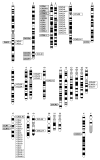The chemokine superfamily revisited
- PMID: 22633458
- PMCID: PMC3396424
- DOI: 10.1016/j.immuni.2012.05.008
The chemokine superfamily revisited
Abstract
The chemokine superfamily consists of a large number of ligands and receptors. At first glance, this family appears redundant and their ligand-receptor relationships promiscuous, making its study challenging. However, analyzing this family from the evolutionary perspective greatly simplifies understanding both the organization and function of this apparently complex system. In particular, the functions of a subgroup of chemokines (designated homeostatic chemokines) have played pivotal roles in advancing our understanding of the organization and function of the cellular networks that shape the immune system. Here, we update the full scope of the human and mouse chemokine superfamilies and their relationships and summarize several important roles that homeostatic chemokines play in the immune system.
Copyright © 2012 Elsevier Inc. All rights reserved.
Figures
References
-
- Albert ML, Casrouge A, Chevaliez S, Hezode C, Rosa I, Renard P, Mallet V, Fontanet A, Pawlotsky JM, Pol S. Interferon induced protein 10 remains a useful biomarker of treatment failure in patients stratified for the interleukin-28B rs12979860 haplotype. Hepatology. 2011;53:1410–1411. - PubMed
-
- Amanatidou V, Zaravinos A, Apostolakis S, Spandidos DA. Chemokines in respiratory viral infections: focus on their diagnostic and therapeutic potential. Crit Rev Immunol. 2011;31:341–356. - PubMed
-
- Balkwill FR. The chemokine system and cancer. J Pathol. 2012;226:148–157. - PubMed
-
- Bernhagen J, Krohn R, Lue H, Gregory JL, Zernecke A, Koenen RR, Dewor M, Georgiev I, Schober A, Leng L, et al. MIF is a noncognate ligand of CXC chemokine receptors in inflammatory and atherogenic cell recruitment. Nat Med. 2007;13:587–596. - PubMed
Publication types
MeSH terms
Substances
Grants and funding
LinkOut - more resources
Full Text Sources
Other Literature Sources
Medical


